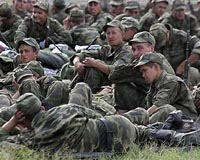 Outside View: Russia's new army structure
Outside View: Russia's new army structure
(NSI News Source Info) Moscow - October 24, 2008: The Russian army is changing. In addition to troop-size reduction, yet another reform is aimed at fundamentally changing personnel composition and structure, especially within the ground forces.
Until now, despite all recent reforms and cutbacks, the Russian armed forces largely remained a scaled-down version of the Soviet army, which was supposed to lead a full-scale war preceded by a general mobilization. Under present circumstances, however, the probability of such a war is relatively low. In the case of a nuclear conflict, there will be no time for a general mobilization, while a local conflict can be won without resorting to such measures. So what will the Russian military look like after reform?
The main change will be a move from the current vertical chain of command of the Russian armed forces, a military district-army-division-regiment structure, to a military district-operative command-brigade regime, in order to increase efficiency by abolishing redundant elements. Mobile permanent readiness brigades, consisting of battalions, will be capable of operating tactical maneuver groups, either independently or together with other brigades under joint command.
In addition, each military district in the Russian Federation will establish rapid-response brigades that most likely will be formed out of airborne units.
Other important news is the plan to change the personnel composition of the Russian armed forces, including reducing the commissioned officers' numbers from the current more than 400,000 -- more than 30 percent of the current 1.2 million servicemen -- to around 150,000 -- 15 percent of the future 1 million-strong force. The cutback mostly will affect logistics and staff commissioned officers and generals, while the number of first and second lieutenants will increase from 50,000 to 60,000.
A reduction in commissioned officer numbers will be accompanied by a boost in the size of the sergeant corps. The sergeant corps will play a much larger role in the future Russian army. Well-trained and experienced professional sergeants will ensure fast and effective training of privates, both contract soldiers and conscripts.
Although the new military reform is to be finished by 2012, some unofficial sources have told RIA Novosti that the main reduction will take place within the next year.
If this is true, a significant number of discharged officers from the Russian army will have to face the problem of civil readjustment. Official Russian government sources report, however, that the reduction will be done by attrition, by retiring commissioned officers who have exceeded their term of required service. This is difficult to believe, however.


















No comments:
Post a Comment